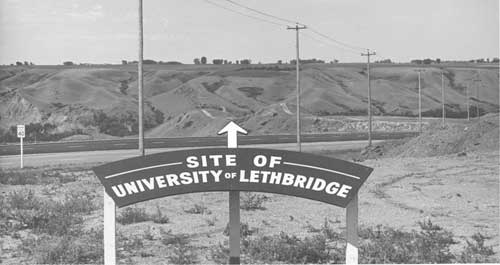The general purpose statement said it succinctly, " . . . to begin the process of establishing the academic philosophy and objectives of The University of Lethbridge."
Over the course of four days in the fall of 1967, 20 delegates and a trio of invited resource guests charted the course of the fledgling University of Lethbridge at the Waterton Conference. The goal was to produce a statement of philosophy that would in turn be reflected in the academic program of the University. It was essentially a blank canvas with which to work, and the University's founders went about crafting a philosophy that is remarkably relevant to this day.

In looking back at documents in advance of the conference, acting president R.J. Leskiw (W.A. Sam Smith would begin his appointment later that year) elicited resources from a trio of outside agencies. A.J. Brumbaugh of the Southern Regional Educational Board in Atlanta, Georgia, along with representatives from the province's Universities Commission and Post-Secondary Education Committee contributed to the process.
Leskiw's letter inviting Brumbaugh is telling in that it sets the framework for the discussion and uses language still prevalent in conversations today.
How large an institution do we want our University to be in terms of student enrolment? Will the University confine its program to the undergraduate level or is the intention to introduce graduate programs eventually? What type of institution will the University be, i.e. a liberal arts college, an institution with a liberal arts core and professional schools established eventually? These were all questions put to Brumbaugh by Leskiw.
In Brumbaugh's reply letter, he says, "The problems and specific questions you suggest for consideration in the conference are very appropriate," he writes. "One omission that may be of special interest is the question of what innovations will be included in the plans of the University? I refer to such matters as independent study . . . the use of individual study carrels, a combination of work and study, study abroad."
The group would also discuss how many faculties they should plan to create initially and in the future, the nature of the administrative organization and the University's admissions policy, themes that continue to resonate as the present
U of L continually looks at these issues, always with an eye to the foundation laid by its builders.
At the conclusion of the summit, the University Philosophy was born and continues to guide the U of L of today.
That the University's founders were so prescient in their thinking is testament to the visionaries that were at the table. This excerpt from a Leskiw letter is almost eerie in its foretelling.
"The University of Lethbridge is not located in a large metropolitan area as are the other two universities in this province," says Leskiw. "There is some reason to believe, therefore, that if the University of Lethbridge is to succeed, and in fact survive, it must become an institution that is unique. It must somehow be an institution that differs from the two older ones in this province."
He could not be more correct.
This story first appeared in the April 2012 issue of the Legend. To view the entire issue in a flipbook format, follow this link.
